The Consistency of SSM/I vs. SSMIS and the Influence on Snow Cover Detection and Snow Depth Estimation over China
Abstract
1. Introduction
2. Materials and Methods
2.1. Data
2.2. Methodology
3. Results
3.1. Comparison between SSM/I and SSMIS Brightness Temperature
3.2. Comparison between SSM/I and SSMIS Snow Cover Detection
3.3. Comparison between SSM/I and SSMIS Snow Depth
4. Discussion
4.1. The Influence of Snow Depth on Brightness Temperature Bias
4.2. Brightness Temperature Bias in Different Seasons
4.3. The Biases in Different Climatological Snow Classes
4.4. Intercalibration in Different Sensors
5. Conclusions
Author Contributions
Funding
Acknowledgments
Conflicts of Interest
References
- Bormann, J.; Brown, R.; Derksen, C.; Painter, H. Estimating snow-cover trends from space. Nat. Clim. Chang. 2018, 8, 924–928. [Google Scholar] [CrossRef]
- Derksen, C.; Brown, R. Spring snow cover extent reductions in the 2008–2012 period exceeding climate model projections. Geophys. Res. Lett. 2012, 39, 1–6. [Google Scholar] [CrossRef]
- Fernandes, R.; Zhao, H.; Wang, X.; Key, J.; Qu, X.; Hall, A. Controls on Northern Hemisphere snow albedo feedback quantified using satellite Earth observations. Geophys. Res. Lett. 2009, 36, 1–6. [Google Scholar] [CrossRef]
- Hernández-Henríquez, M.; Déry, S.; Derksen, C. Polar amplification and elevation-dependence in trends of Northern Hemisphere snow cover extent, 1971–2014. Environ. Res. Lett. 2015, 10, 044010. [Google Scholar] [CrossRef]
- Takala, M.; Ikonen, J.; Luojus, K.; Lemmetyinen, J.; Metsamaki, S.; Cohen, J.; Nadir, A.; Pulliainen, J. New Snow Water Equivalent Processing System with Improved Resolution Over Europe and its Applications in Hydrology. IEEE J. Sel. Top. Appl. Earth Obs. Remote Sens. 2017, 10, 428–436. [Google Scholar] [CrossRef]
- Lemmetyinen, J.; Schwank, M.; Rautiainen, K.; Kontu, A.; Parkkinen, T.; Mätzler, C.; Wiesmann, A.; Wegmüller, U.; Derksen, C.; Toose, P.; et al. Snow density and ground permittivity retrieved from L-band radiometry: Application to experimental data. Remote Sens. Environ. 2016, 180, 377–391. [Google Scholar] [CrossRef]
- Safavi, H.; Sajjadi, S.; Raghibi, V. Assessment of climate change impacts on climate variables using probabilistic ensemble modeling and trend analysis. Theor. Appl. Climatol. 2017, 130, 635–653. [Google Scholar] [CrossRef]
- De Rosnay, P.; Balsamo, G.; Albergel, C.; Muñoz-Sabater, J.; Isaksen, L. Initialisation of land surface variables for numerical weather prediction. Surv. Geophys. 2014, 35, 607–621. [Google Scholar] [CrossRef]
- Bell, V.; Kay, A.; Davies, H.; Jones, R. An assessment of the possible impacts of climate change on snow and peak river flows across Britain. Clim. Chang. 2016, 136, 539–553. [Google Scholar] [CrossRef]
- Barnett, T.P.; Adam, J.; Lettenmaier, D. Potential impacts of a warming climate on water availability in snow-dominated regions. Nature 2005, 438, 303–309. [Google Scholar] [CrossRef] [PubMed]
- Takala, M.; Luojus, K.; Pulliainen, J.; Derksen, C.; Lemmetyinen, J.; Kärnä, J.-P.; Koskinen, J.; Bojkov, B. Estimating northern hemisphere snow water equivalent for climate research through assimilation of space-borne radiometer data and ground-based measurements. Remote Sens. Environ. 2011, 115, 3517–3529. [Google Scholar] [CrossRef]
- Che, T.; Dai, L.; Zheng, X.; Li, X.; Zhao, K. Estimation of snow depth from passive microwave brightness temperature data in forest regions of northeast China. Remote Sens. Environ. 2016, 183, 334–349. [Google Scholar] [CrossRef]
- Dai, L.; Che, T.; Ding, Y.; Hao, X. Evaluation of snow cover and snow depth on the Qinghai–Tibetan Plateau derived from passive microwave remote sensing. Cryosphere 2017, 11, 1933–1948. [Google Scholar] [CrossRef]
- Luojus, K.; Pullianinen, J.; Takala, M.; Lemmetyinen, J.; Kangwa, M.; Smolander, T.; Derksen, C.; Pinnock, S. ESA Globsnow: Algorithm Theoretical Basis Document-SWE-algorithm. Technical Report, European Space Agency (ESA). 2013. Available online: http://cedadocs.ceda.ac.uk/id/eprint/1263 (accessed on 13 May 2019).
- Armstrong, R.; Knowles, K.; Brodzik, M.; Hardman, M. DMSP SSM/I-SSMIS Pathfinder Daily EASE-Grid Brightness Temperatures, Version 2; NASA National Snow and Ice Data Center Distributed Active Archive Center: Boulder, CO, USA, 1994. [Google Scholar] [CrossRef]
- Berg, W.; Kroodsma, R.; Kummerow, C.D.; McKague, D.S. Fundamental Climate Data Records of Microwave Brightness Temperatures. Remote Sens. 2018, 10, 1306. [Google Scholar] [CrossRef]
- Kelly, R. The AMSR-E snow depth algorithm: Description and initial results. J. Remote Sens. Soc. Jpn. 2009, 29, 307–317. [Google Scholar] [CrossRef]
- Knowles, K.; Njoku, E.; Armstrong, R.; Brodzik, M. Nimbus-7 SMMR Pathfinder Daily EASE-Grid Brightness Temperatures, Version 1; NASA National Snow and Ice Data Center Distributed Active Archive Center: Boulder, CO, USA, 2000. [Google Scholar] [CrossRef]
- Kawanishi, T.; Sezai, T.; Ito, Y.; Imaoka, K.; Takeshima, T.; Ishido, Y.; Shibata, A.; Miura, M.; Inahata, H.; Spencer, R. The Advanced Scanning Microwave Radiometer for the Earth Observing System (AMSR-E): NASDA’s contribution to the EOS for global energy and water cycle studies. IEEE Trans. Geosci. Remote Sens. 2003, 41, 184–194. [Google Scholar] [CrossRef]
- Imaoka, K.; Takashi, M.; Misako, K.; Marehito, K.; Norimasa, I.; Keizo, N. Status of AMSR2 instrument on GCOM-W1, earth observing missions and sensors: Development, implementation, and characterization II. Proc. SPIE 2012, 8528, 852815. [Google Scholar] [CrossRef]
- Yang, H.; Weng, F.; Lv, L.; Lu, N.; Liu, G.; Bai, M.; Qian, Q.; He, J.; Xu, H. The FengYun-3 microwave radiation imager on-orbit verification. IEEE Trans. Geosci. Remote Sens. 2011, 49, 4552–4560. [Google Scholar] [CrossRef]
- Pulliainen, J.; Grandell, J.; Hallikainen, M. HUT snow emission model and its applicability to snow water equivalent retrieval. IEEE Trans. Geosci. Remote Sens. 1999, 37, 1378–1390. [Google Scholar] [CrossRef]
- Pulliainen, J. Mapping of snow water equivalent and snow depth in boreal and sub-arctic zones by assimilating space-borne microwave radiometer data and ground-based observations. Remote Sens. Environ. 2006, 101, 257–269. [Google Scholar] [CrossRef]
- Dai, L.; Che, T.; Ding, Y. Inter-Calibrating SMMR, SSM/I and SSMI/S Data to Improve the Consistency of Snow-Depth Products in China. Remote Sens. 2015, 7, 7212–7230. [Google Scholar] [CrossRef]
- Che, T.; Li, X.; Jin, R.; Armstrong, R.; Zhang, T. Snow depth derived from passive microwave remote-sensing data in China. Ann. Glaciol. 2008, 49, 145–154. [Google Scholar] [CrossRef]
- Dai, L.; Che, T.; Wang, J.; Zhang, P. Snow depth and snow water equivalent estimation from AMSR-E data based on a priori snow characteristics in Xinjiang, China. Remote Sens. Environ. 2012, 127, 14–29. [Google Scholar] [CrossRef]
- Larue, F.; Royer, A.; DeSève, D.; Langlois, A.; Roy, A.; Brucker, L. Validation of GlobSnow-2 snow water equivalent over Eastern Canada. Remote Sens. Environ. 2017, 194, 264–277. [Google Scholar] [CrossRef]
- Pulliainen, J.; Aurela, M.; Laurila, T.; Aalto, T.; Takala, M.; Salminen, M.; Kulmala, M.; Barr, A.; Heimann, M.; Lindroth, A. Early snowmelt significantly enhances boreal springtime carbon uptake. Proc. Natl. Acad. Sci. USA 2017, 114, 11081–11086. [Google Scholar] [CrossRef] [PubMed]
- Chander, G.; Hewison, T.; Fox, N.; Wu, X.; Xiong, X.; Blackwell, W. Overview of Intercalibration of Satellite Instruments. IEEE Trans. Geosci. Remote Sens. 2013, 51, 1056–1080. [Google Scholar] [CrossRef]
- Derksen, C.; Walker, A. Identification of systematic bias in the cross-platform (SMMR and SSM/I) EASE-grid brightness temperature time series. IEEE Trans. Geosci. Remote Sens. 2003, 41, 910–915. [Google Scholar] [CrossRef]
- Cavalieri, D.; Parkinson, C.; DiGirolamo, N.; Ivanoff, A. Intersensor Calibration Between F13 SSMI and F17 SSMIS for Global Sea Ice Data Records. IEEE Geosci. Remote Sens. Lett. 2012, 9, 233–236. [Google Scholar] [CrossRef]
- Okuyama, A.; Imaoka, K. Intercalibration of Advanced Microwave Scanning Radiometer-2 (AMSR2) Brightness Temperature. IEEE Trans. Geosci. Remote Sens. 2015, 53, 4568–4577. [Google Scholar] [CrossRef]
- Meier, W.; Khalsa, S.; Savoie, M. Intersensor calibration between F-13 SSM/I and F-17 SSMIS near-real-time sea ice estimates. IEEE Trans. Geosci. Remote Sens. 2011, 49, 3343–3349. [Google Scholar] [CrossRef]
- Cho, E.; Tuttle, S.E.; Jacobs, J.M. Evaluating Consistency of Snow Water Equivalent Retrievals from Passive Microwave Sensors over the North Central U. S.: SSM/I vs. SSMIS and AMSR-E vs. AMSR2. Remote Sens. 2017, 9, 465. [Google Scholar] [CrossRef]
- Yan, B.; Weng, F.; Okamoto, K. Improved estimation of snow emissivity from 5 to 200 GHz. In Proceedings of the 8th Specialist Meeting on Microwave Radiometry and Remote Sensing Applications, Rome, Italy, 24–27 February 2004. [Google Scholar]
- Yan, B.; Weng, F. Intercalibration Between Special Sensor Microwave Imager/Sounder and Special Sensor Microwave Imager. IEEE Trans. Geosci. Remote Sens. 2008, 46, 4. [Google Scholar] [CrossRef]
- Cao, C.; Weinreb, M.; Xu, H. Predicting simultaneous nadir overpasses among polar-orbiting meteorological satellites for the intersatellite calibration of radiometers. J. Atmos. Ocean. Technol. 2004, 21, 537–542. [Google Scholar] [CrossRef]
- Du, J.; Kimball, J.S.; Shi, J.; Jones, L.A.; Wu, S.; Sun, R.; Yang, H. Inter-Calibration of Satellite Passive Microwave Land Observations from AMSR-E and AMSR2 Using Overlapping FY3B-MWRI Sensor Measurements. Remote Sens. 2014, 6, 8594–8616. [Google Scholar] [CrossRef]
- Jiang, L.; Wang, P.; Zhang, L.; Yang, H.; Yang, J. Improvement of snow depth retrieval for FY3B-MWRI in China. Sci. China Earth Sci. 2014, 44, 531–547. [Google Scholar] [CrossRef]
- Sturm, M.; Holmgren, J.; Liston, G.E. A seasonal snow cover classification system for local to global applications. J. Clim. 1995, 8, 1261–1283. [Google Scholar] [CrossRef]
- Grody, N.; Basist, A. Global identification of snowcover using SSM/I measurements. IEEE Trans. Geosci. Remote Sens. 1996, 34, 237–249. [Google Scholar] [CrossRef]
- Li, X.; Liu, Y.; Zhu, X.; Zheng, Z.; Chen, A. Snow Cover Identification with SSM/I Data in China. J. Appl. Meteorol. Sci. 2007, 18, 12–20. [Google Scholar]
- Liu, X.; Jiang, L.; Wu, S.; Hao, S.; Wang, G.; Yang, J. Assessment of Methods for Passive Microwave Snow Cover Mapping Using FY-3C/MWRI Data in China. Remote Sens. 2018, 10, 524. [Google Scholar] [CrossRef]
- Yang, J.; Jiang, L.; Wu, S.; Liu, X.; Wang, G.; Hao, S.; Wang, J. Improvement of Snow Depth Estimation Using SSM/I Brightness Temperature in China. In Proceedings of the IGARSS 2018—2018 IEEE International Geoscience and Remote Sensing Symposium, Valencia, Spain, 22–27 July 2018; pp. 5089–5092. [Google Scholar] [CrossRef]
- Derksen, C.; Toose, P.; Rees, A.; Wang, L.; English, M.; Walker, A.; Sturm, M. Development of a tundra-specific snow water equivalent retrieval algorithm for satellite passive microwave data. Remote Sens. Environ. 2010, 114, 1699–1709. [Google Scholar] [CrossRef]
- Jiang, L.; Shi, J.; Tjuatja, S. Estimation of Snow Water Equivalence Using the Polarimetric Scanning Radiometer From the Cold Land Processes Experiments (CLPX03). IEEE Geosci. Remote Sens. Lett. 2011, 8, 359–363. [Google Scholar] [CrossRef]
- Cai, S.; Li, D.; Durand, M.; Margulis, S.A. Examination of the impacts of vegetation on the correlation between snow water equivalent and passive microwave brightness temperature. Remote Sens. Environ. 2017, 193, 244–256. [Google Scholar] [CrossRef]
- Li, Q.; Kelly, R. Correcting Satellite Passive Microwave Brightness Temperatures in Forested Landscapes Using Satellite Visible Reflectance Estimates of Forest Transmissivity. IEEE J. Sel. Top. Appl. Earth Obs. Remote Sens. 2017, 10, 3874–3883. [Google Scholar] [CrossRef]
- Li, Q.; Kelly, R.; Leppanen, L.; Juho, V.; Kontu, A.; Lemmetyinen, J.; Pulliainen, J. The Influence of Thermal Properties and Canopy-Intercepted Snow on Passive Microwave Transmissivity of a Scots Pine. IEEE Trans. Geosci. Remote Sens. 2019, 99, 1–10. [Google Scholar] [CrossRef]
- Dahe, Q.; Shiyin, L.; Peiji, L. Snow cover distribution, variability, and response to climate change in western China. J. Clim. 2006, 19, 1820–1833. [Google Scholar] [CrossRef]
- Yang, J.; Jiang, L.; Ménard, C.B.; Luojus, K.; Lemmetyinen, J.; Pulliainen, J. Evaluation of snow products over the Tibetan Plateau. Hydrol. Process. 2015, 29, 3247–3260. [Google Scholar] [CrossRef]
- Tedesco, M.; Jeyaratnam, J. A New Operational Snow Retrieval Algorithm Applied to Historical AMSR-E Brightness Temperatures. Remote Sens. 2016, 8, 1037. [Google Scholar] [CrossRef]
- Yang, J.; Jiang, L.; Wu, S.; Wang, G.; Wang, J.; Liu, X. Development of a Snow Depth Estimation Algorithm over China for the FY-3D/MWRI. Remote Sens. 2019, 11, 977. [Google Scholar] [CrossRef]
- Shi, L.; Qiu, Y.; Shi, J.; Lemmetyinen, J.; Zhao, S. Estimation of Microwave Atmospheric Transmittance Over China. IEEE Geosci. Remote Sens. Lett. 2017, 99, 1–5. [Google Scholar] [CrossRef]
- Ji, D.; Shi, J. Water Vapor Retrieval Over Cloud Cover Area on Land Using AMSR-E and MODIS. IEEE J. Sel. Top. Appl. Earth Obs. Remote Sens. 2014, 7, 3105–3116. [Google Scholar] [CrossRef]
- Xue, Y.; Forman, B. Atmospheric and Forest Decoupling of Passive Microwave Brightness Temperature Observations Over Snow-Covered Terrain in North America. IEEE J. Sel. Top. Appl. Earth Obs. Remote Sens. 2016, 99, 1–18. [Google Scholar] [CrossRef]
- Du, J.; Kimball, J.; Jones, L. Satellite Microwave Retrieval of Total Precipitable Water Vapor and Surface Air Temperature Over Land from AMSR2. IEEE Trans. Geosci. Remote Sens. 2015, 53, 2520–2531. [Google Scholar] [CrossRef]
- Gu, L.; Zhao, K.; Huang, B. Microwave Unmixing With Video Segmentation for Inferring Broadleaf and Needleleaf Brightness Temperatures and Abundances from Mixed Forest Observations. IEEE Trans. Geosci. Remote Sens. 2016, 54, 279–286. [Google Scholar] [CrossRef]
- Liu, X.; Jiang, L.; Wang, G.; Hao, S.; Chen, Z. Using a Linear Unmixing Method to Improve Passive Microwave Snow Depth Retrievals. IEEE J. Sel. Top. Appl. Earth Obs. Remote Sens. 2018, 11, 4414–4429. [Google Scholar] [CrossRef]
- Leppänen, L.; Kontu, A.; Vehviläinen, J.; Lemmetyinen, J.; Pulliainen, J. Comparison of traditional and optical grain-size field measurements with SNOWPACK simulations in a taiga snowpack. J. Glaciol. 2015, 61, 151–162. [Google Scholar] [CrossRef]
- Durand, M.; Gatebe, C.; Kim, E.; Molotch, N.; Painter, T.; Raleigh, M.; Sandells, M.; Vuyovich, C. NASA SnowEx Science Plan: Assessing approaches for measuring water in Earth’s seasonal snow, Version 1.6; National Aeronautics and Space Administration (NASA): Washington, DC, USA, 2019; Available online: https://goo.gl/sFkxHc (accessed on 13 July 2019).
- Foster, J.L.; Sun, C.J.; Walker, J.P.; Kelly, R.; Chang, A.; Dong, J.R.; Powell, H. Quantifying the uncertainty in passive microwave snow water equivalent observations. Remote Sens. Environ. 2005, 94, 187–203. [Google Scholar] [CrossRef]

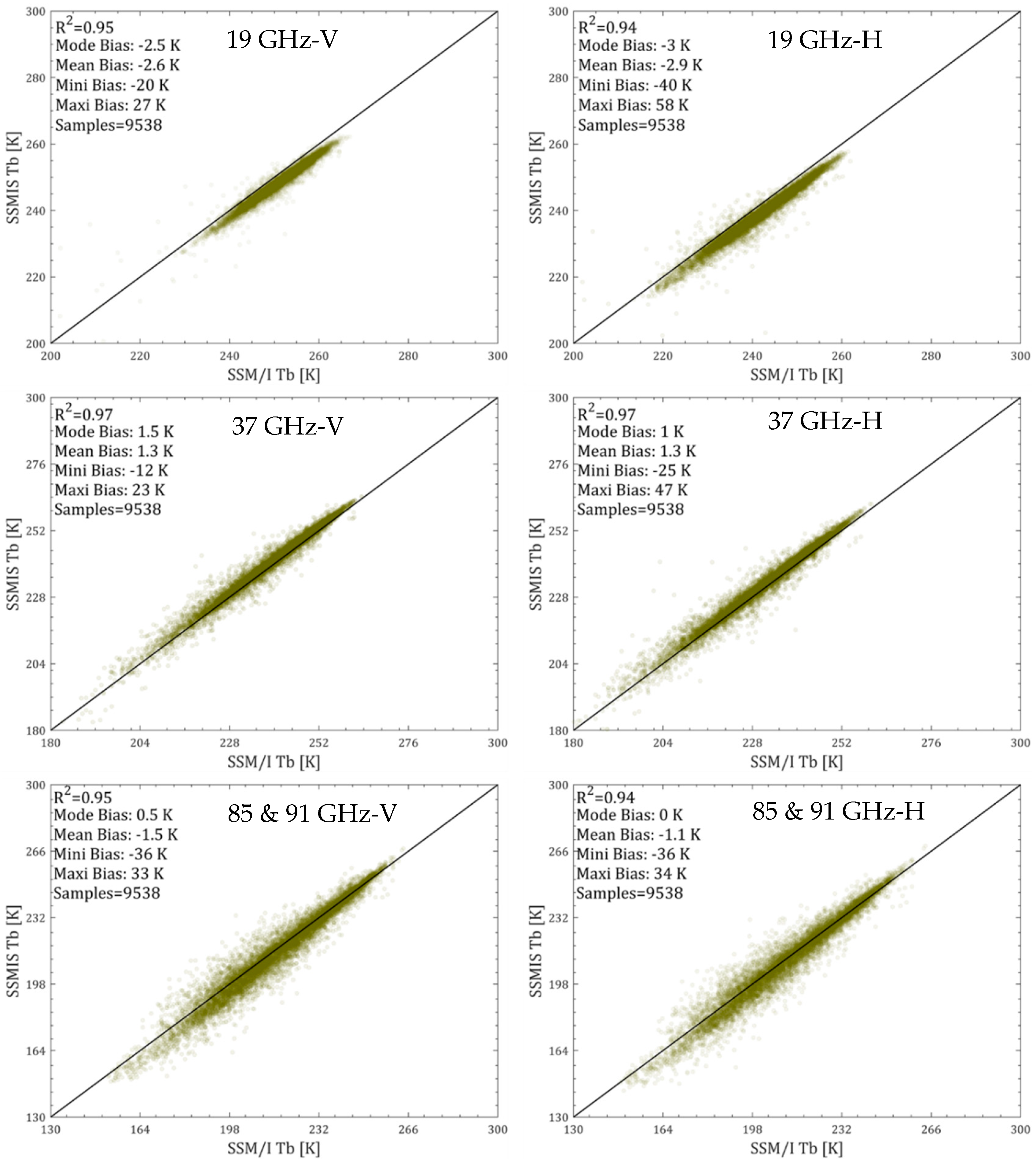
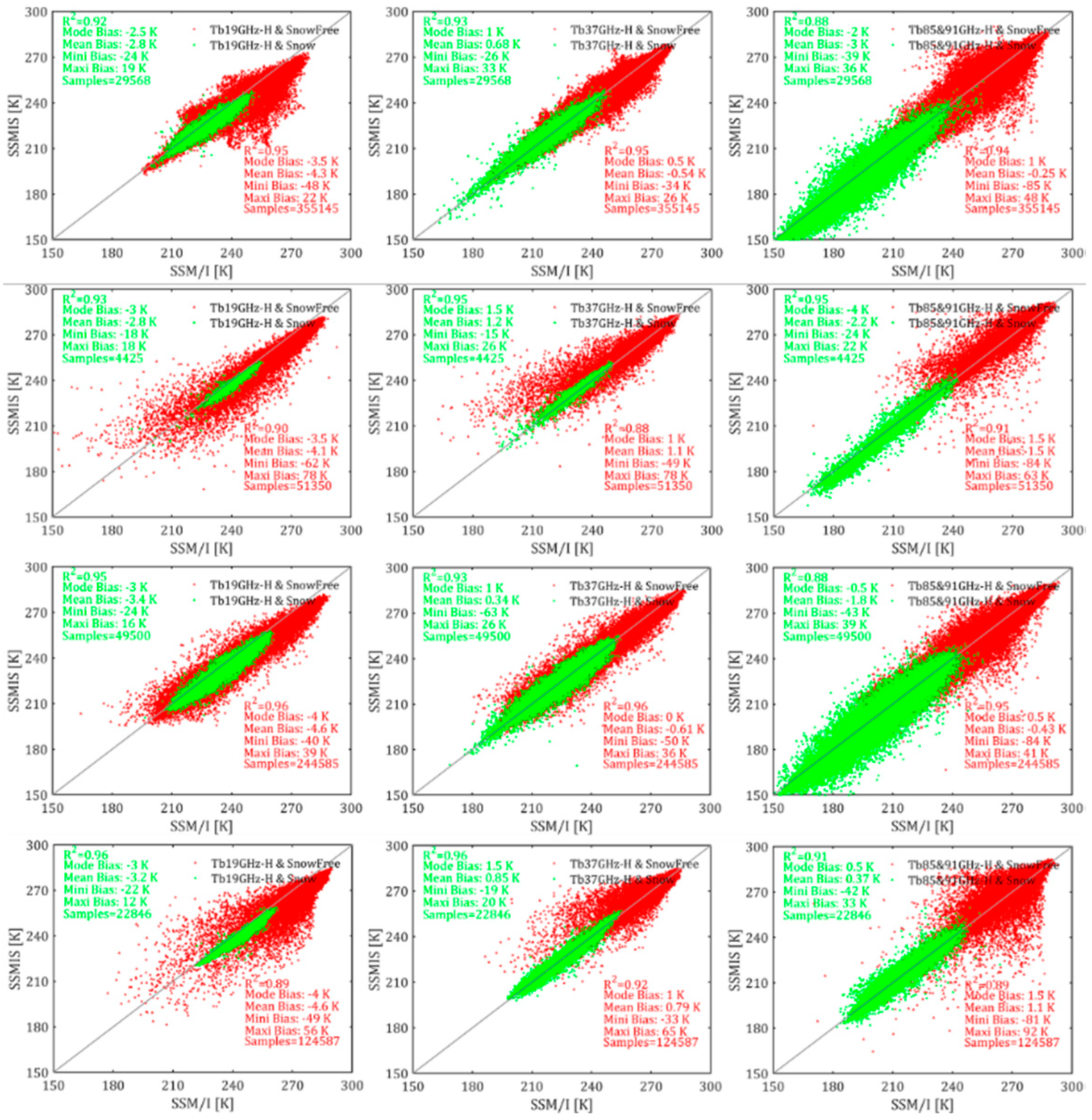

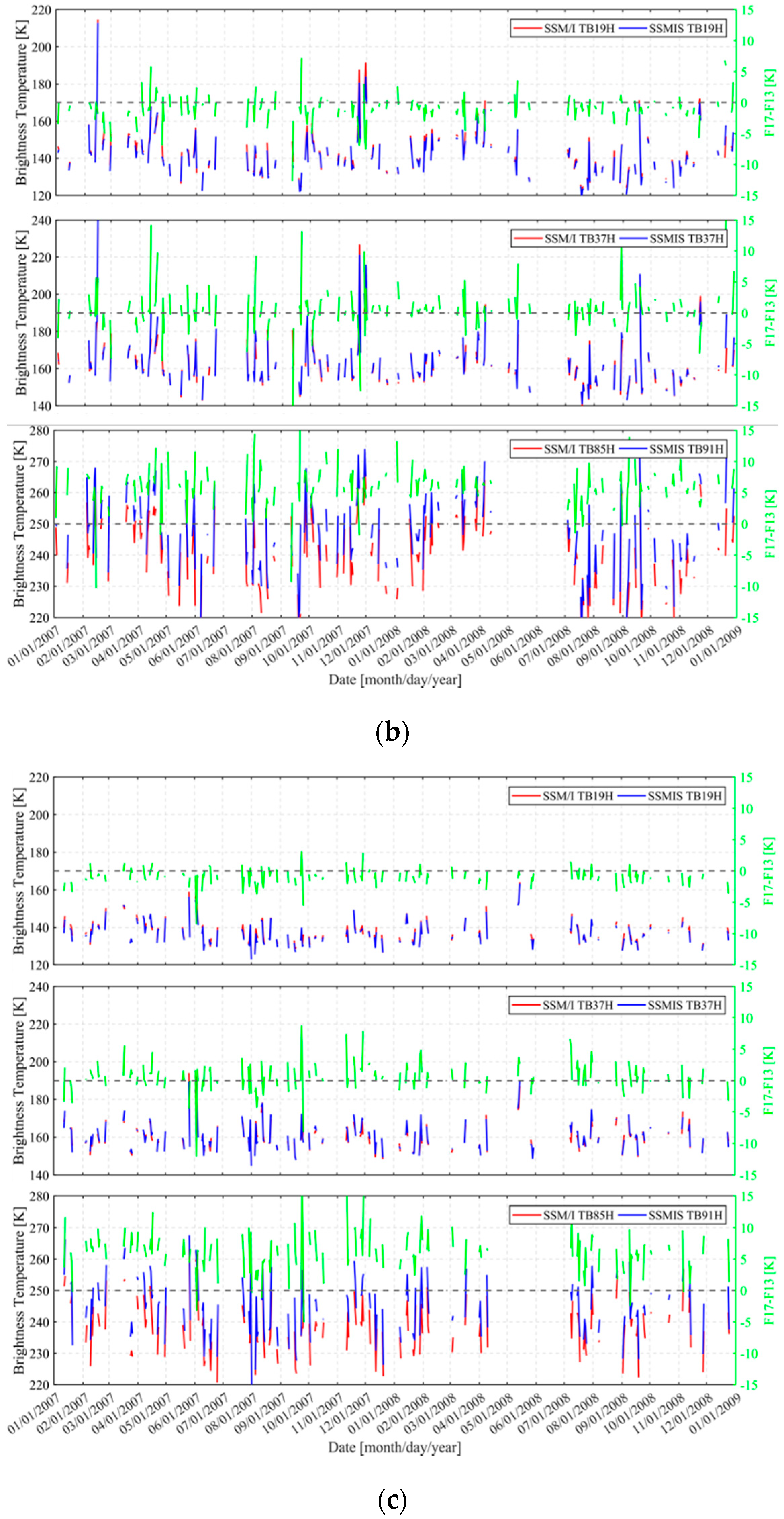
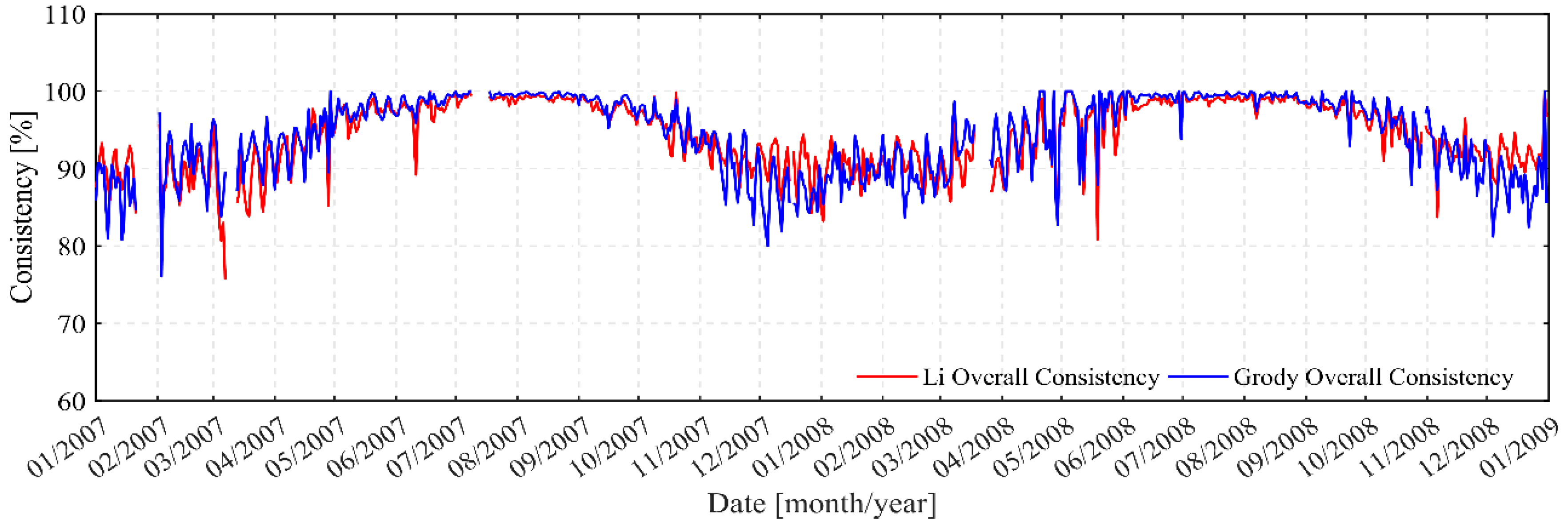
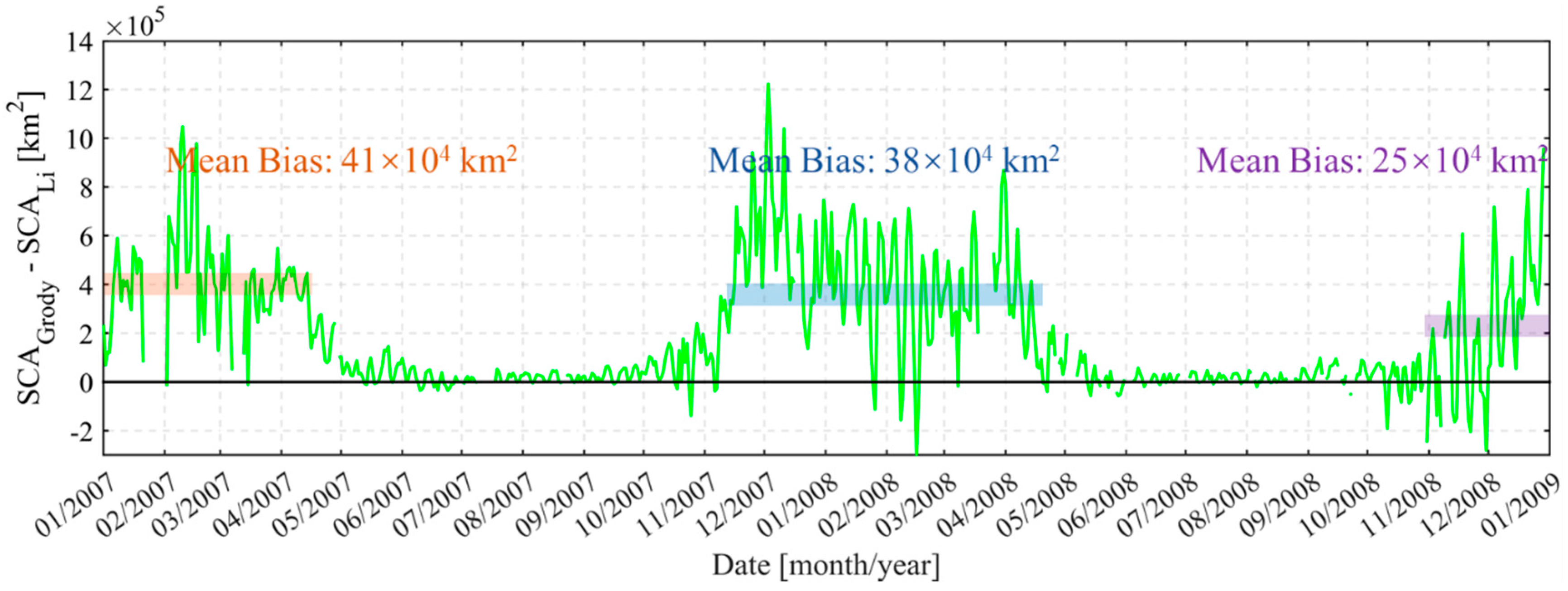
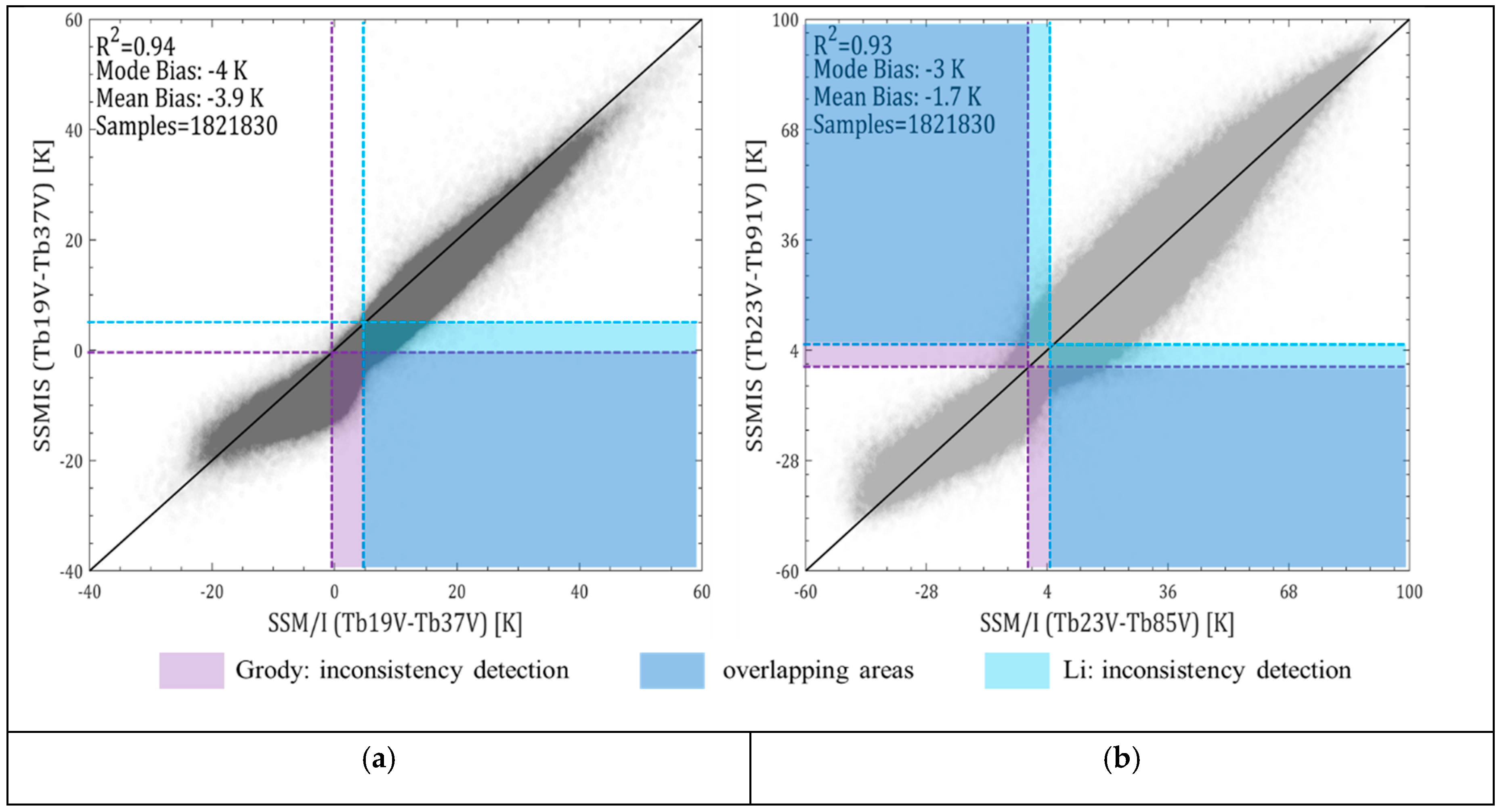
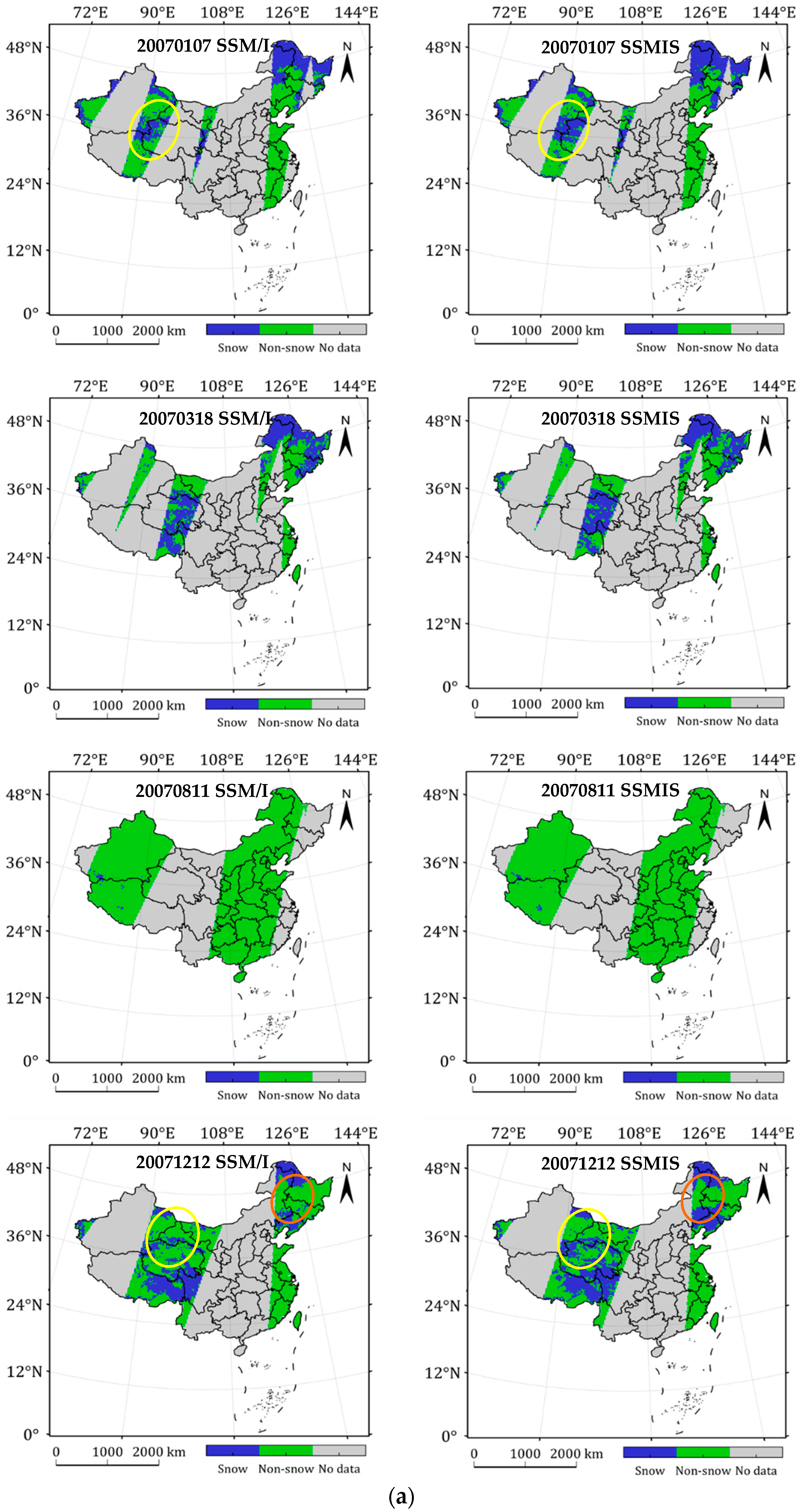

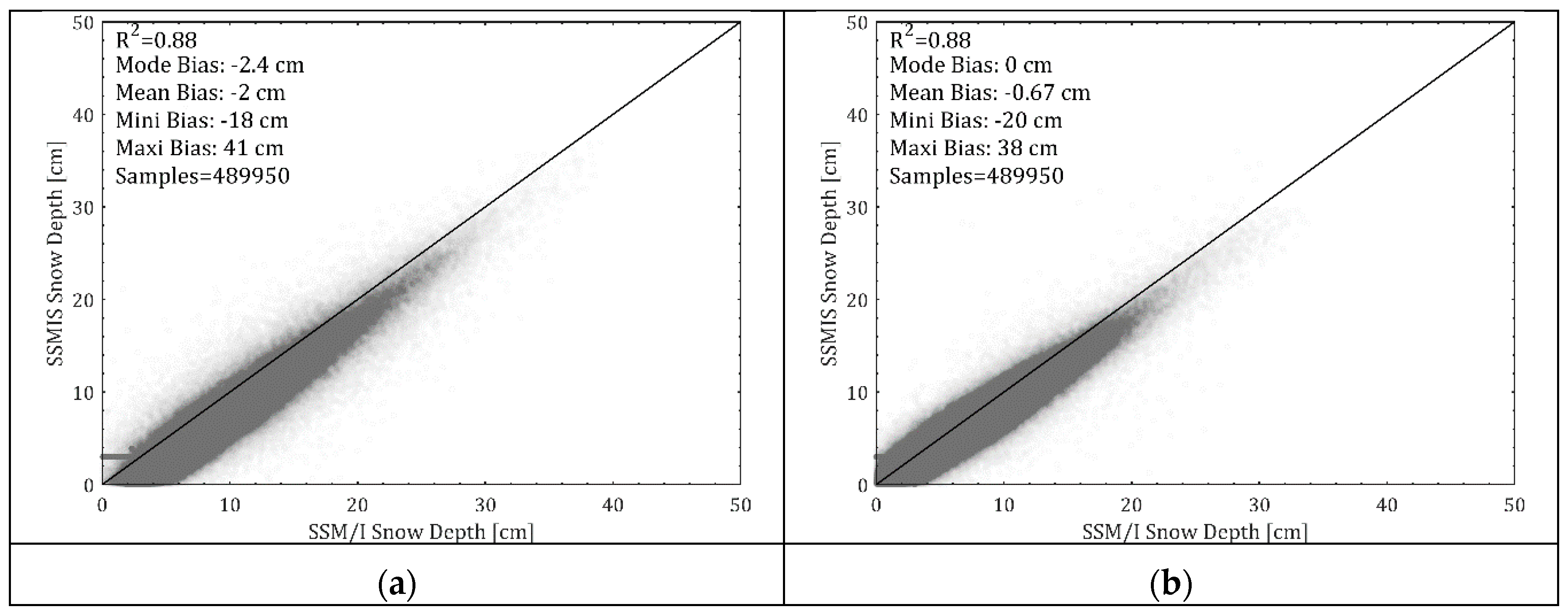
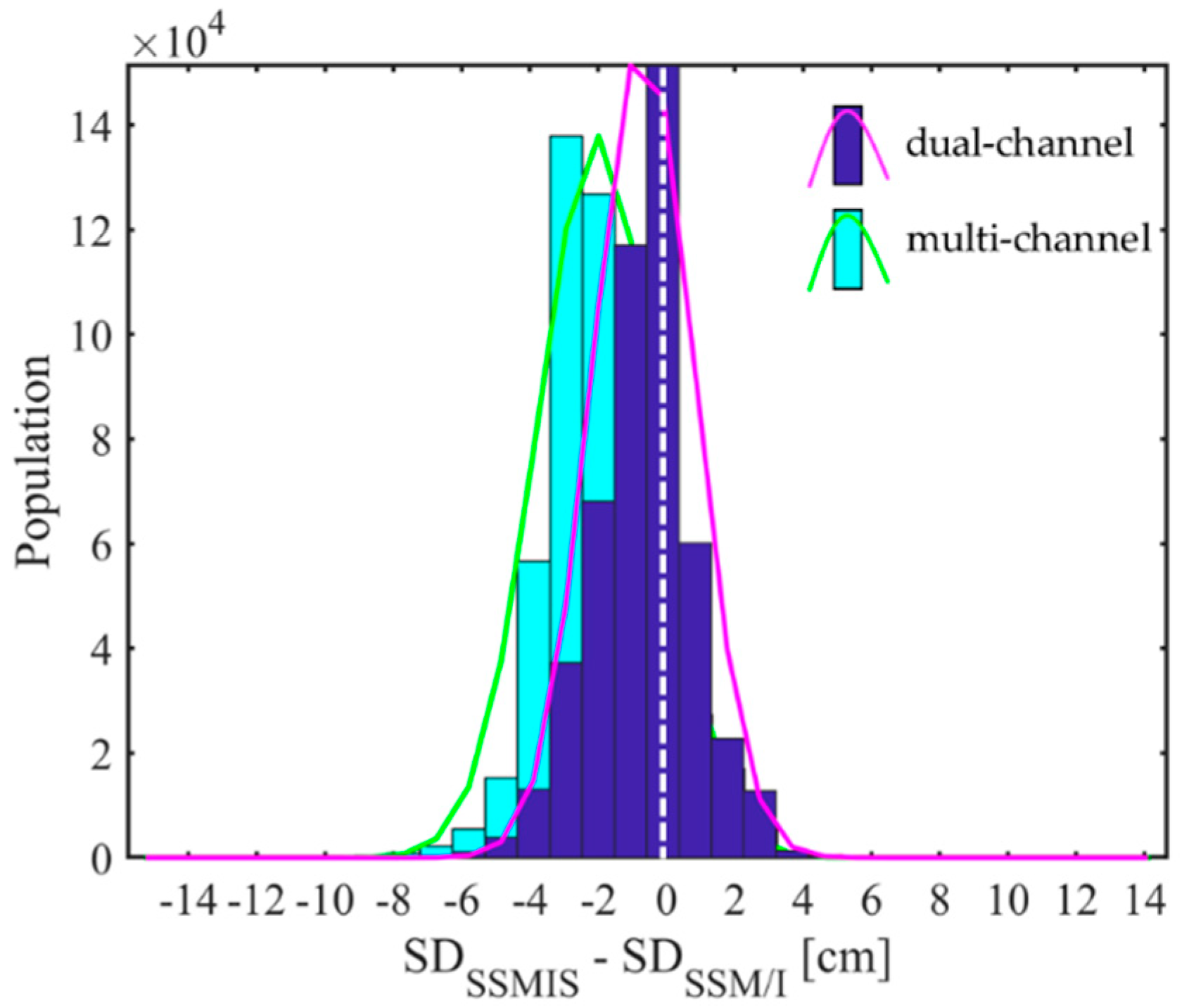
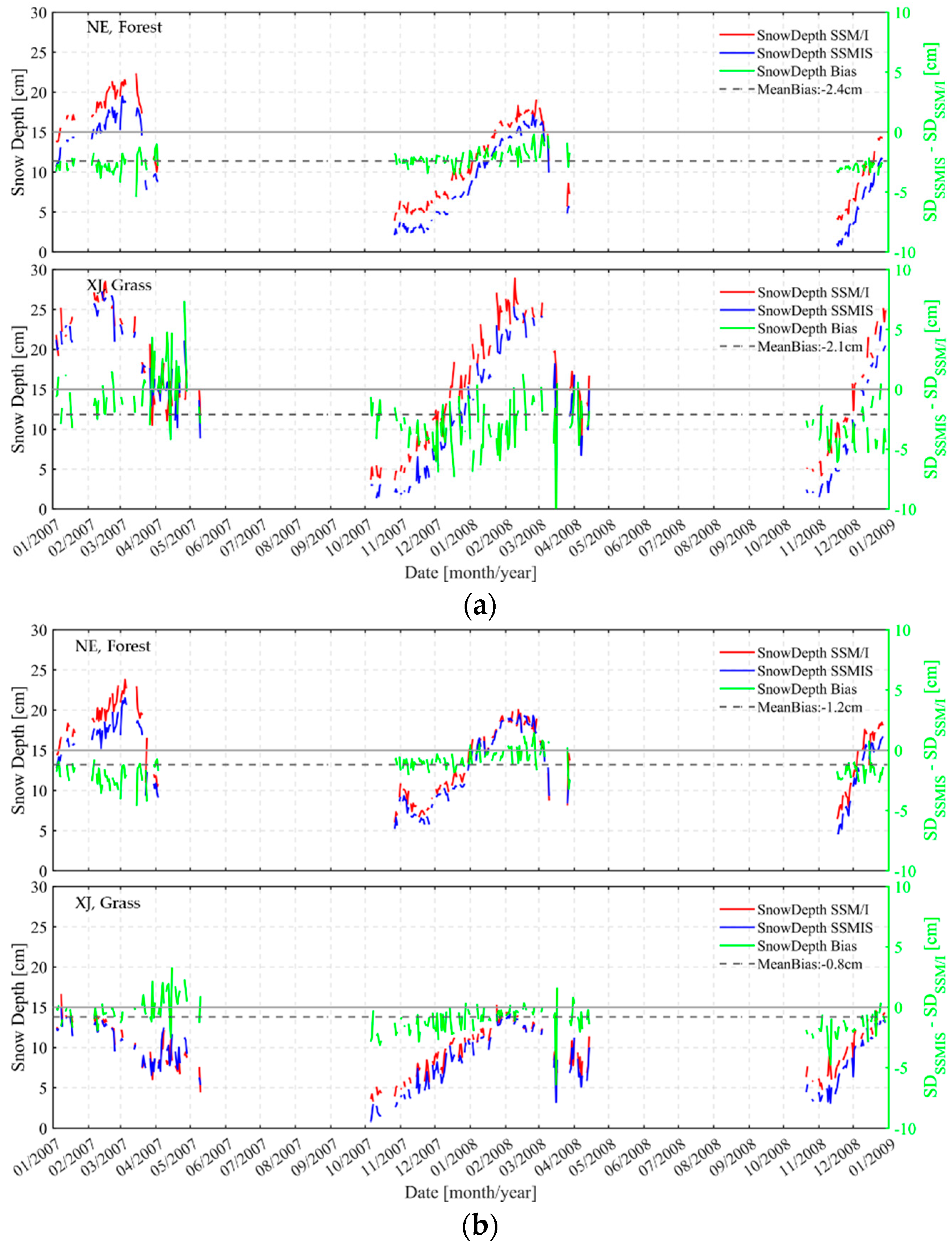
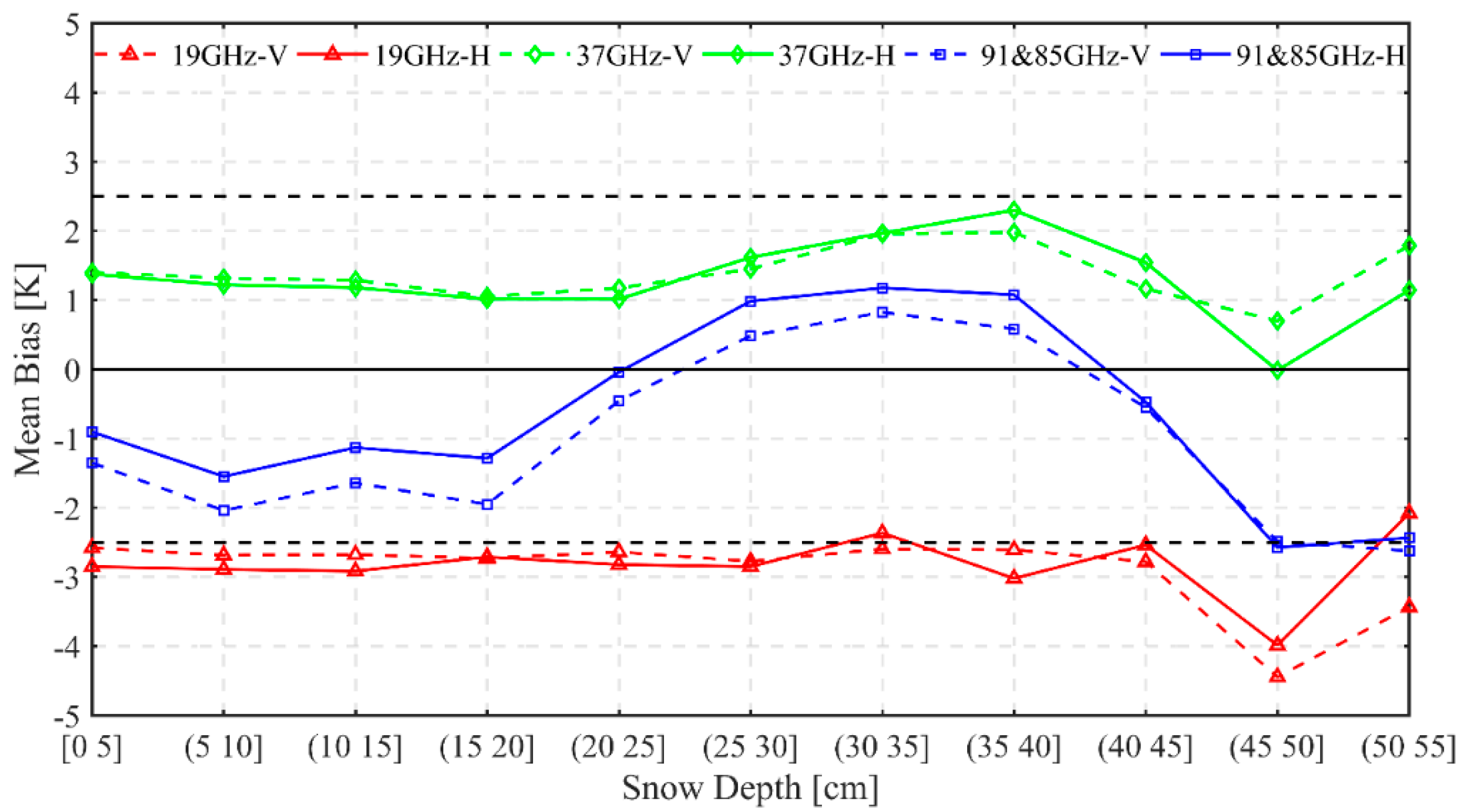
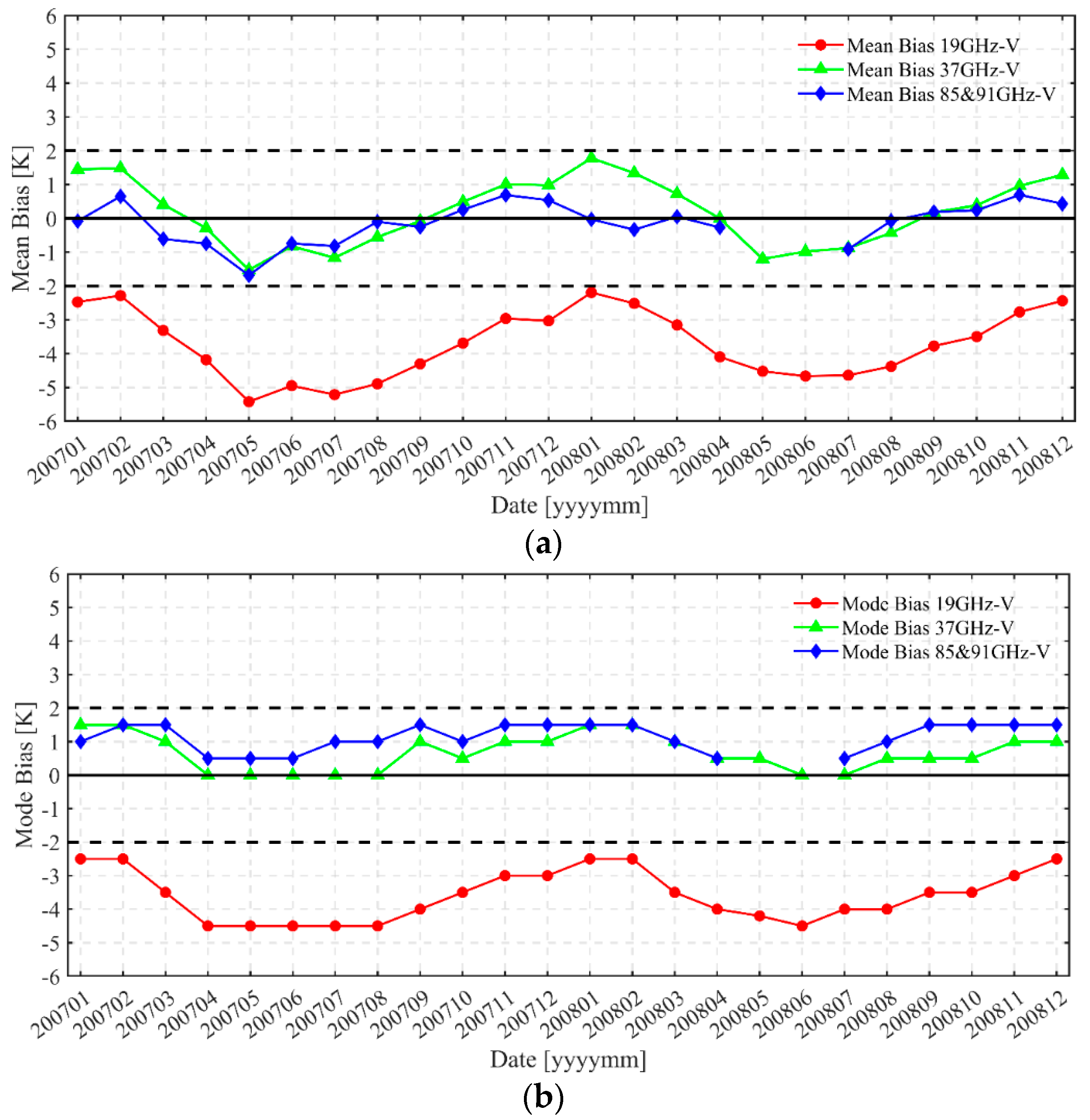
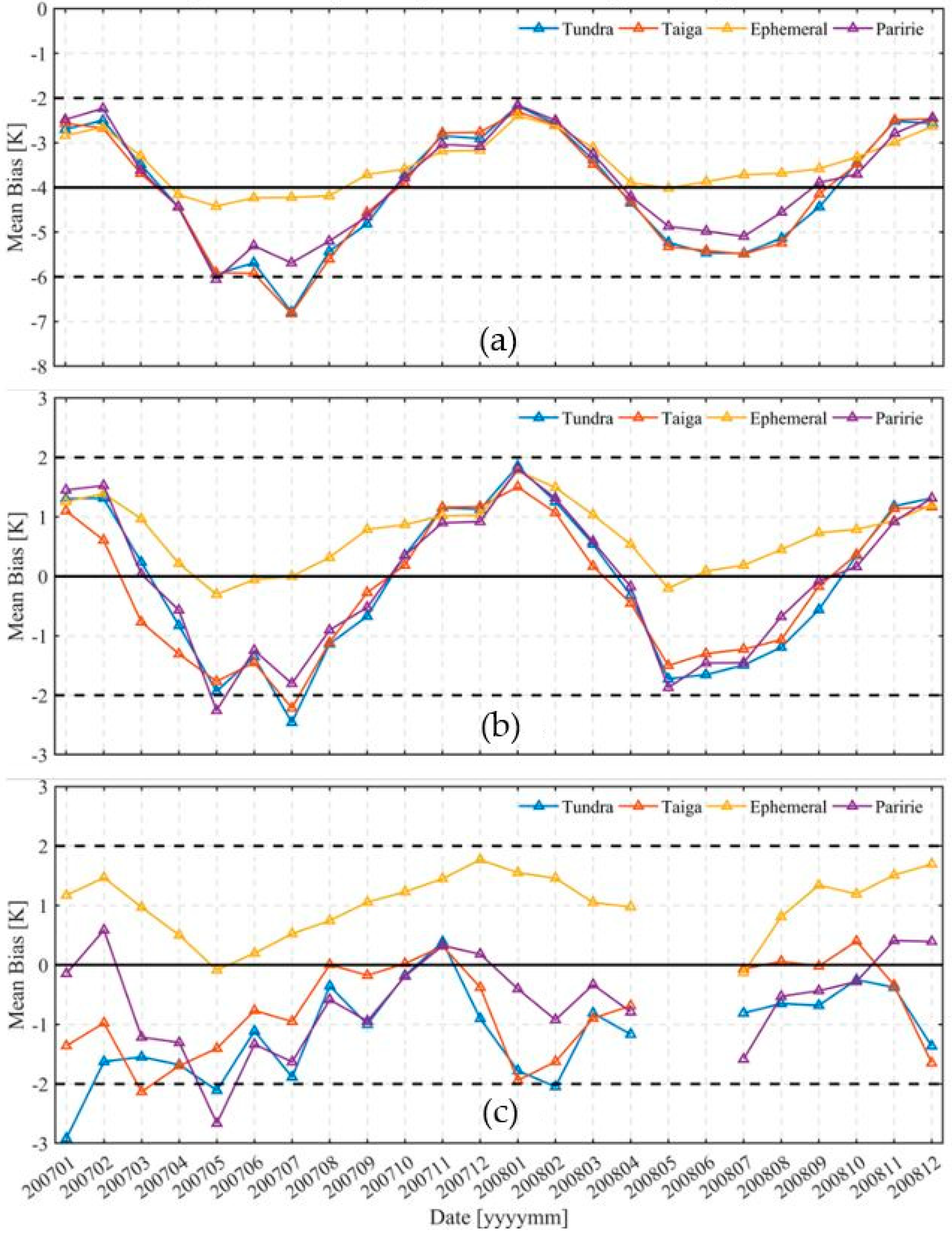

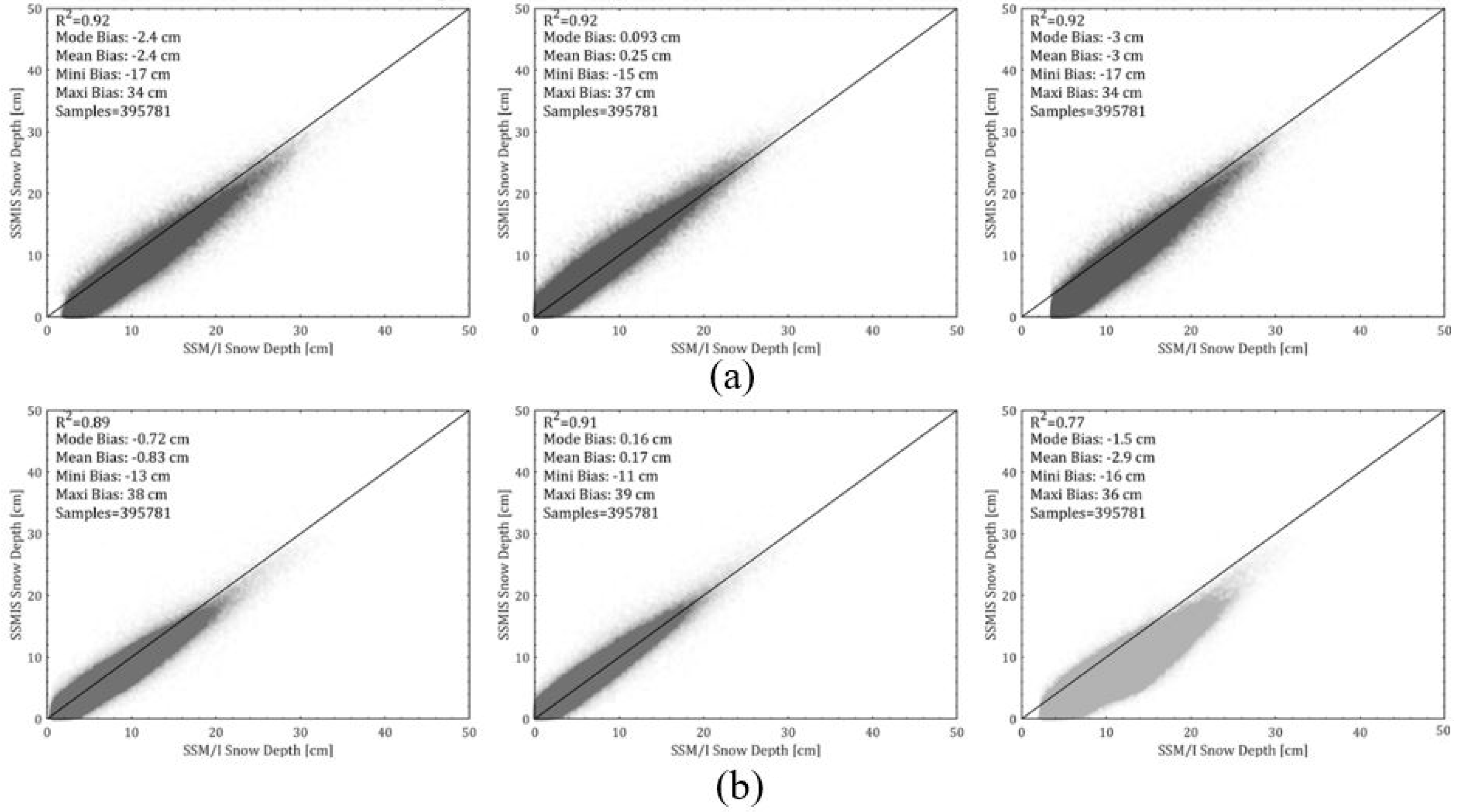
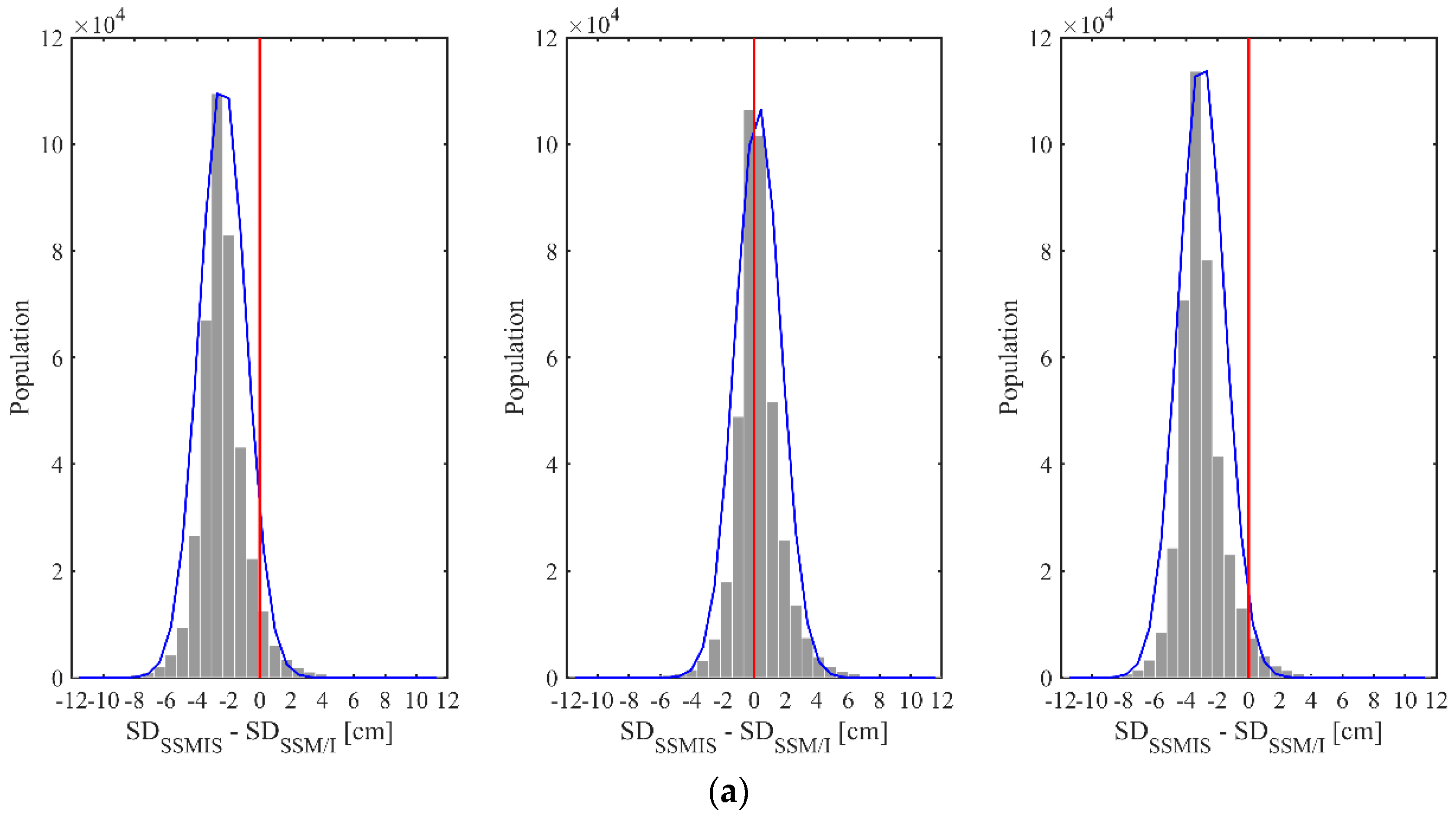
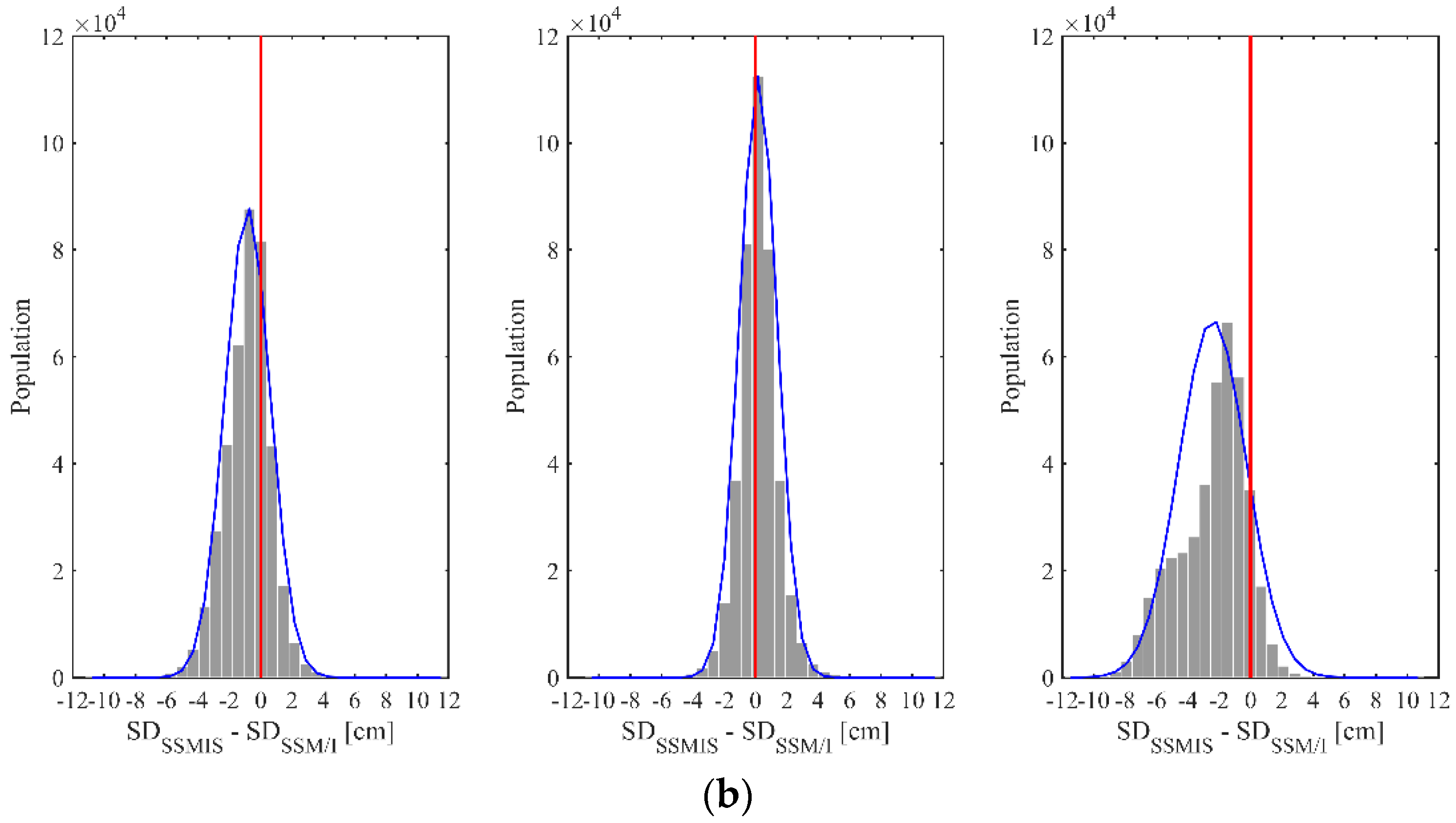
| Satellite platforms | DMSP-F13 | DMSP-F17 |
|---|---|---|
| Sensors | SSM/I | SSMIS |
| Temporal Range | 1995–2009 | 2006–the present |
| Passing time | A: 17:58 D: 05:58 | A: 17:31 D: 05:31 |
| Footprint (km × km) | 19.35: 45 × 68 23.235: 40 × 60 37: 24 × 36 85.5: 11 × 16 | 19.35: 42 × 70 23.235: 42 × 70 37: 28 × 44 91.655: 13 × 15 |
| Viewing angle (°) | 53.1 | 53.1 |
| Data acquisition | daily | daily |
| Swath width (km) | 1400 | 1700 |
| Snow Class | Snow Depth Range (cm) | Snow Density (g·cm−3) | Number of Layers |
|---|---|---|---|
| Taiga | 30~120 | 0.26 | >15 |
| Tundra | 10~70 | 0.38 | 0~6 |
| Prairie | 0~50 | no data | <5 |
| Ephemeral | 0~50 | no data | 0~3 |
| Methods | Classification Criteria | ||
|---|---|---|---|
| Grody (1996) | Scattering Materials: (Tb23V − Tb89V) > 0 or (Tb19V − Tb37V) > 0 | ||
| Snow | Snow-free | ||
| Does not meet the criteria of non-snow | Precipitation | Tb23V ≥ 258 or Tb23V ≥ (165 + 0.49 × Tb89V) or 254 ≤ Tb23V ≤ 258 & ((Tb23V − Tb89V) ≤ 2 or (Tb19V − Tb37V) ≤ 2) | |
| Cold desert | (Tb19V − Tb19H) ≥ 18 & (Tb19V − Tb37V) ≤ 10 & (Tb37V − Tb89V) ≤ 10 | ||
| Frozen ground | (Tb19V − Tb19H) ≥ 18 & (Tb23V − Tb89V) ≤ 6 & (Tb19V − Tb37V) ≤ 2 | ||
| Glacier | (Tb23V ≤ 229 & (Tb19V − Tb19H) ≥ 23) or Tb23V ≤ 210 | ||
| Li (2007) | Scattering materials: (Tb23V − Tb89V) ≥ 5 or (Tb19V − Tb37V) ≥ 5 | ||
| Snow-free | snow | ||
| Tb23V > 260 | Tb23V ≤ 260 | ||
| (Tb19V − Tb37V) < 20 & SI < 8 & SI > −5 & ((Tb19V − Tb19H) > 6 or (Tb19V − Tb37V) < 10) | Thick dry snow | (Tb19V − Tb37V) ≥ 20 & SI ≥ 8 | |
| Thick wet snow | (Tb19V − Tb37V) ≥ 20 & SI < 8 | ||
| Thin dry snow | (Tb19V − Tb37V) < 20 & SI ≥ 8 | ||
| Thin wet snow or forested thin snow | (Tb19V − Tb37V) < 20 & SI < 8 & SI > −5 & (Tb19V − Tb19H) ≤ 6 & (Tb19V − Tb37V) ≥ 10 | ||
| Thicker wet snow | (Tb19V − Tb37V) < 20 & SI < 8 & SI ≤ −5 | ||
| SSM/I: Snow | SSM/I: Snow-Free | |
|---|---|---|
| SSMIS: snow | consistency snow (CS) | inconsistency2 (IC2) |
| SSMIS: snow-free | Inconsistency 1 (IC1) | consistency non-snow (CN) |
| Overall consistency (OC): (CS + CN)/(CS + CN + IC1 + IC2) | ||
| Land Cover | Snow Cover | 19 GHz Bias (K) | 37 GHz Bias (K) | 85&91 GHz Bias (K) | ||||||
|---|---|---|---|---|---|---|---|---|---|---|
| Mean | Min | Max | Mean | Min | Max | Mean | Min | Max | ||
| Barren | Y | −2.5 | −24 | 19 | 0.7 | −26 | 33 | −3.0 | −39 | 36 |
| N | −4.3 | −48 | 22 | −0.5 | −34 | 26 | −0.3 | −85 | 48 | |
| Farmland | Y | −2.8 | −18 | 18 | 1.2 | −15 | 26 | −2.2 | −24 | 22 |
| N | −4.1 | −62 | 78 | 1.1 | −49 | 78 | 1.5 | −84 | 63 | |
| Grassland | Y | −3.4 | −24 | 16 | 0.3 | −63 | 26 | −1.8 | −43 | 39 |
| N | −4.6 | −40 | 39 | −0.6 | −50 | 36 | −0.4 | −84 | 41 | |
| Forest | Y | −3.2 | −22 | 12 | 0.9 | −19 | 20 | 0.4 | −42 | 33 |
| N | −4.6 | −49 | 56 | 0.8 | −33 | 65 | 1.1 | −81 | 92 | |
| Year | Method | Four Seasons | |||
|---|---|---|---|---|---|
| DJF | MAM | JJA | SON | ||
| 2007 | Li | 89.8 | 92.9 | 98.6 | 95.0 |
| Grody | 88.1 | 94.3 | 99.2 | 95.2 | |
| 2008 | Li | 90.8 | 93.4 | 98.8 | 95.1 |
| Grody | 89.0 | 94.8 | 99.3 | 95.2 | |
| Channels | Snow Cover (Group 1) | All (Group 2) | |||
|---|---|---|---|---|---|
| Calibration | R2 | Calibration | R2 | ||
| 19 GHz | V | y = 0.9362x + 13.352 | 0.948 | y = 0.8926x + 24.407 | 0.954 |
| H | y = 0.9253x + 15.134 | 0.941 | y = 0.8825x + 25.422 | 0.940 | |
| 37 GHz | V | y = 0.9903x + 3.675 | 0.974 | y = 0.9577x + 10.908 | 0.963 |
| H | y = 0.9873x + 4.231 | 0.966 | y = 0.9320x + 11.830 | 0.954 | |
| 85&91 GHz | V | y = 1.0381x − 9.783 | 0.945 | y = 1.0162x − 4.731 | 0.962 |
| H | y = 1.0302x − 7.440 | 0.943 | y = 1.0145x − 3.692 | 0.956 | |
© 2019 by the authors. Licensee MDPI, Basel, Switzerland. This article is an open access article distributed under the terms and conditions of the Creative Commons Attribution (CC BY) license (http://creativecommons.org/licenses/by/4.0/).
Share and Cite
Yang, J.; Jiang, L.; Dai, L.; Pan, J.; Wu, S.; Wang, G. The Consistency of SSM/I vs. SSMIS and the Influence on Snow Cover Detection and Snow Depth Estimation over China. Remote Sens. 2019, 11, 1879. https://doi.org/10.3390/rs11161879
Yang J, Jiang L, Dai L, Pan J, Wu S, Wang G. The Consistency of SSM/I vs. SSMIS and the Influence on Snow Cover Detection and Snow Depth Estimation over China. Remote Sensing. 2019; 11(16):1879. https://doi.org/10.3390/rs11161879
Chicago/Turabian StyleYang, Jianwei, Lingmei Jiang, Liyun Dai, Jinmei Pan, Shengli Wu, and Gongxue Wang. 2019. "The Consistency of SSM/I vs. SSMIS and the Influence on Snow Cover Detection and Snow Depth Estimation over China" Remote Sensing 11, no. 16: 1879. https://doi.org/10.3390/rs11161879
APA StyleYang, J., Jiang, L., Dai, L., Pan, J., Wu, S., & Wang, G. (2019). The Consistency of SSM/I vs. SSMIS and the Influence on Snow Cover Detection and Snow Depth Estimation over China. Remote Sensing, 11(16), 1879. https://doi.org/10.3390/rs11161879







